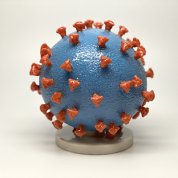
On the Cover
3-D print of a SARS-CoV-2—the virus that causes Covid-19—particle. The virus surface (blue) is covered with spike proteins (red) that enable the virus to enter and infect human cells. The spikes on the surface of coronaviruses give this virus family its name—corona, which is Latin for “crown.” Most any coronavirus will have a crown-like appearance.
NIH





